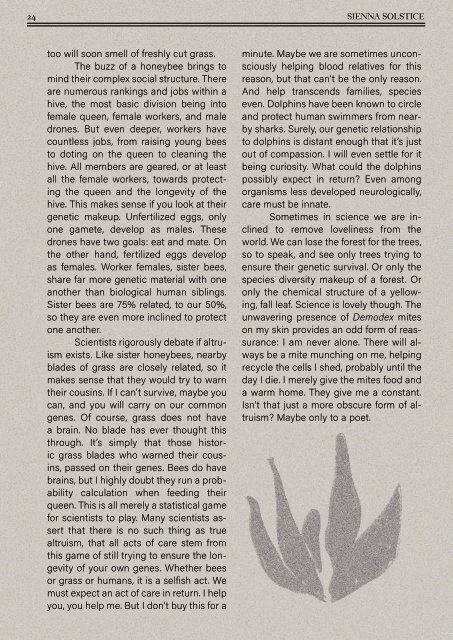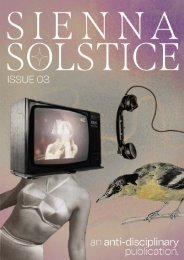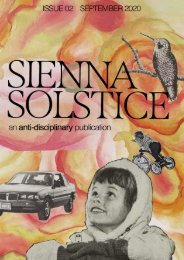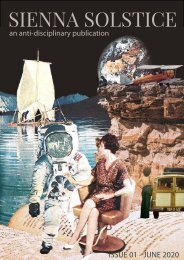You also want an ePaper? Increase the reach of your titles
YUMPU automatically turns print PDFs into web optimized ePapers that Google loves.
24 SIENNA SOLSTICE<br />
too will soon smell of freshly cut grass.<br />
The buzz of a honeybee brings to<br />
mind their complex social structure. There<br />
are numerous rankings and jobs within a<br />
hive, the most basic division being into<br />
female queen, female workers, and male<br />
drones. But even deeper, workers have<br />
countless jobs, from raising young bees<br />
to doting on the queen to cleaning the<br />
hive. All members are geared, or at least<br />
all the female workers, towards protecting<br />
the queen and the longevity of the<br />
hive. This makes sense if you look at their<br />
genetic makeup. Unfertilized eggs, only<br />
one gamete, develop as males. These<br />
drones have two goals: eat and mate. On<br />
the other hand, fertilized eggs develop<br />
as females. Worker females, sister bees,<br />
share far more genetic material with one<br />
another than biological human siblings.<br />
Sister bees are 75% related, to our 50%,<br />
so they are even more inclined to protect<br />
one another.<br />
Scientists rigorously debate if altruism<br />
exists. Like sister honeybees, nearby<br />
blades of grass are closely related, so it<br />
makes sense that they would try to warn<br />
their cousins. If I can’t survive, maybe you<br />
can, and you will carry on our common<br />
genes. Of course, grass does not have<br />
a brain. No blade has ever thought this<br />
through. It’s simply that those historic<br />
grass blades who warned their cousins,<br />
passed on their genes. Bees do have<br />
brains, but I highly doubt they run a probability<br />
calculation when feeding their<br />
queen. This is all merely a statistical game<br />
for scientists to play. Many scientists assert<br />
that there is no such thing as true<br />
altruism, that all acts of care stem from<br />
this game of still trying to ensure the longevity<br />
of your own genes. Whether bees<br />
or grass or humans, it is a selfish act. We<br />
must expect an act of care in return. I help<br />
you, you help me. But I don’t buy this for a<br />
minute. Maybe we are sometimes unconsciously<br />
helping blood relatives for this<br />
reason, but that can’t be the only reason.<br />
And help transcends families, species<br />
even. Dolphins have been known to circle<br />
and protect human swimmers from nearby<br />
sharks. Surely, our genetic relationship<br />
to dolphins is distant enough that it’s just<br />
out of compassion. I will even settle for it<br />
being curiosity. What could the dolphins<br />
possibly expect in return? Even among<br />
organisms less developed neurologically,<br />
care must be innate.<br />
Sometimes in science we are inclined<br />
to remove loveliness from the<br />
world. We can lose the forest for the trees,<br />
so to speak, and see only trees trying to<br />
ensure their genetic survival. Or only the<br />
species diversity makeup of a forest. Or<br />
only the chemical structure of a yellowing,<br />
fall leaf. Science is lovely though. The<br />
unwavering presence of Demodex mites<br />
on my skin provides an odd form of reassurance:<br />
I am never alone. There will always<br />
be a mite munching on me, helping<br />
recycle the cells I shed, probably until the<br />
day I die. I merely give the mites food and<br />
a warm home. They give me a constant.<br />
Isn’t that just a more obscure form of altruism?<br />
Maybe only to a poet.






